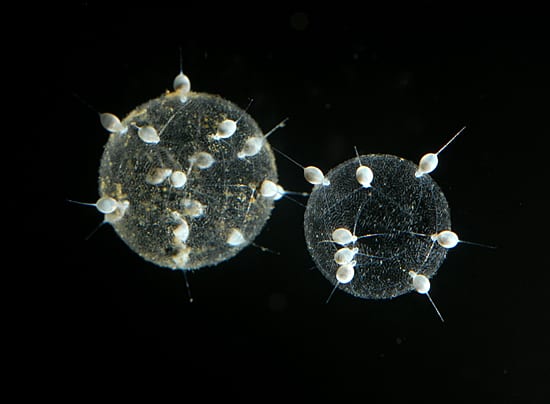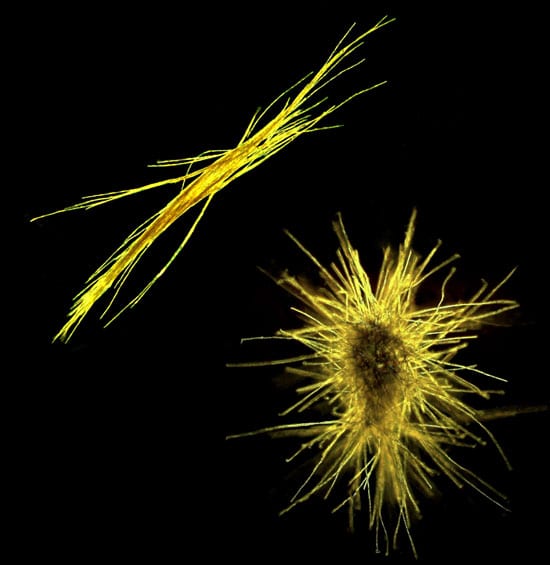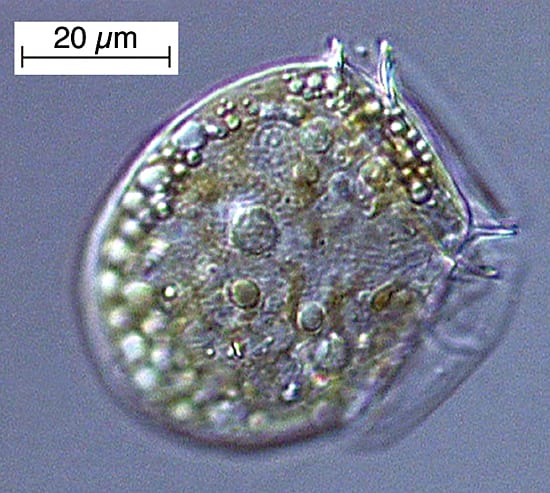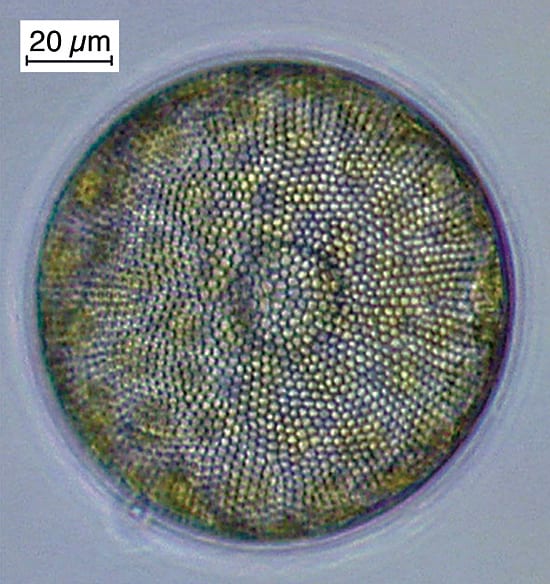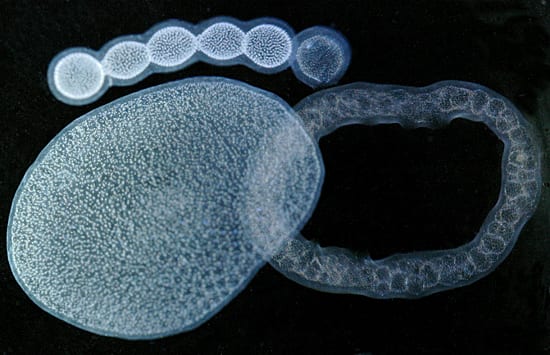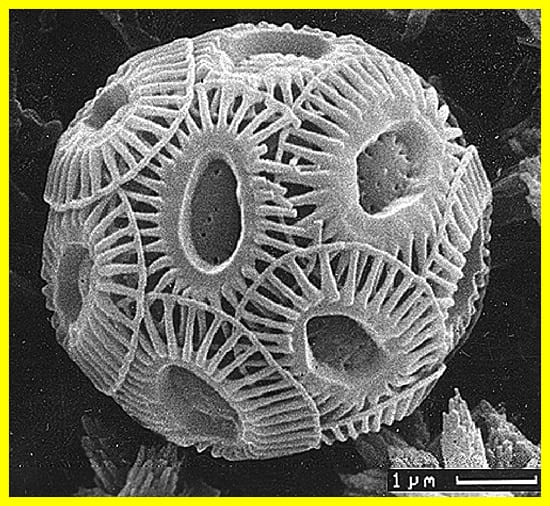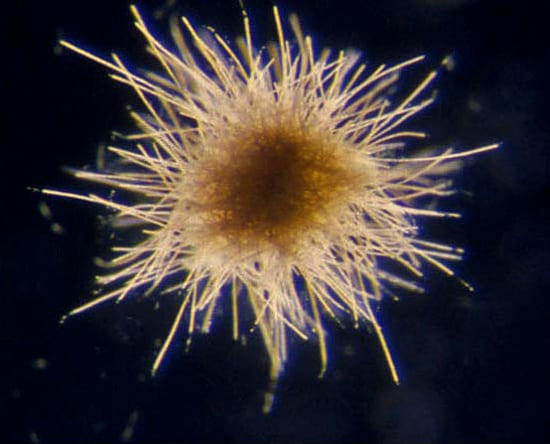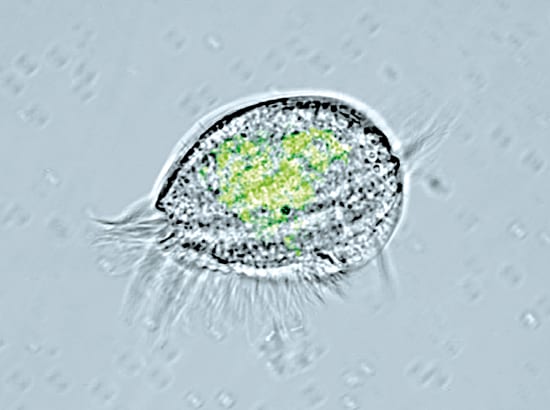 A single-celled organism has eaten bacteria, which are easily visible because they were treated with green dye. Some bacteria can live within organisms, waiting to be released back into the environment, much like the ancient Greeks' tactic in the Trojan War. Matt First, a postdoctoral scientist at WHOI, searches for microbial "Trojan horses" in the ocean. These are bacteria that can resist being digested by the single-celled organisms that eat them. Read more about his work in the latest issue of Oceanus Magazine. (Photo courtesy of Matthew First, Woods Hole Oceanographic Institution)
A single-celled organism has eaten bacteria, which are easily visible because they were treated with green dye. Some bacteria can live within organisms, waiting to be released back into the environment, much like the ancient Greeks' tactic in the Trojan War. Matt First, a postdoctoral scientist at WHOI, searches for microbial "Trojan horses" in the ocean. These are bacteria that can resist being digested by the single-celled organisms that eat them. Read more about his work in the latest issue of Oceanus Magazine. (Photo courtesy of Matthew First, Woods Hole Oceanographic Institution)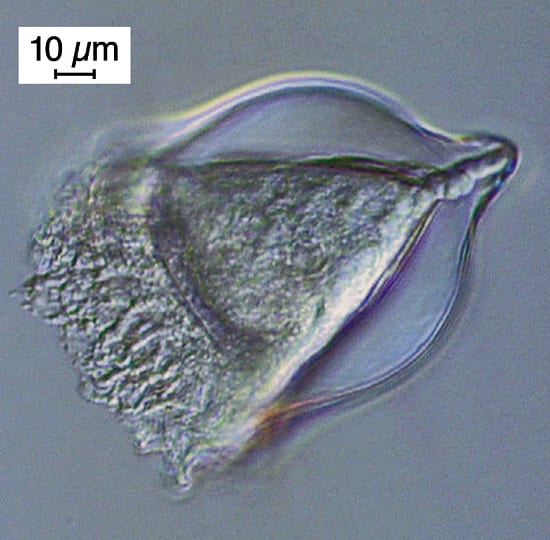 Single-celled organisms like this tintinnid are critical links in the ocean's food web. Though ever-present in the world's oceans, their microscopic sizes make them hard to sample and therefore hard to study. Found in Antarctic waters, this organism has a transparent vase-like shell for protection. Tintinnids consume a variety of cells and non-living particulate organic material, and are 0.02 to 0.1 meter (0.04 to 0.79 inch) long. (Photo by Dawn Moran, Woods Hole Oceanographic Institution)
Single-celled organisms like this tintinnid are critical links in the ocean's food web. Though ever-present in the world's oceans, their microscopic sizes make them hard to sample and therefore hard to study. Found in Antarctic waters, this organism has a transparent vase-like shell for protection. Tintinnids consume a variety of cells and non-living particulate organic material, and are 0.02 to 0.1 meter (0.04 to 0.79 inch) long. (Photo by Dawn Moran, Woods Hole Oceanographic Institution)- They look like space stations, but actually are colonial forms of single-celled organisms called radiolarians, collected in the deep Celebes Sea. The white blobs are individual cells, and the geodesic dome-like structure is the architectural structure of the colony. Radiolarians make such structures out of glass-like slivers of silica. These were collected by Laurence Madin of the Biology Department on a 2006 cruise to explore the deep Celebes Sea, in the Philippines. (Photo by Larry Madin, Woods Hole Oceanographic Institution)
- Trichodesmium, shown in this micrograph, is a photosynthetic bacteria, common in warm, tropical and subtropical surface waters. Trichodesmium cells form filaments called trichomes that associate into the roughly 2mm colonies seen in these images. Turns out this intriguing microbe is also the source of an essential nutrient in the ocean. (Photo by Abby Heithoff, Woods Hole Oceanographic Institution)
- This dinoflagellate, the algae Dinophysis, was collected in the icy waters of the Ross Sea, Antarctica. WHOI biologists are interested in the diversity and activity of protists (protozoa and algae) in the Antarctic marine environment. Becky Gast, Julie Rose, and Dawn Moran—along with colleagues in Dave Caron's lab at the University of Southern California—are using a combination of molecular and microscope-based studies—from photodocumenting single cells to recovering small ribosomal gene sequences—to link the genetic taxonomy with the shape (morphology) of the various cells. (Photo by Dawn Moran, Mark Dennett, and Julie Rose, Woods Hole Oceanographic Institution)
- Viewed end-on, the diatom Coscinodiscus is a study in symmetry, reminiscent of a sunflower. WHOI biologists Dawn Moran and Becky Gast have been collecting, imaging, and cataloguing protists (protozoa and algae) from the Antarctic marine environment, while also studying their genetic makeup. The goal is to chronicle the diversity and activity of protists, and to examine how genes relate to the shape (morphology) of the cells. (Photo by Dawn Moran, Woods Hole Oceanographic Institution)
- Looking like bubbles or smoke rings, these half-inch chains, loops, and spheres are actually common planktonic animals called colonial radiolarians. Each soft shape is hundreds of single-celled animals embedded in a jelly-like substance. Drifting in the ocean's surface waters, they can photosynthesize but are also predators on other small plankton. These were collected by Laurence Madin of the Biology Department on a 2006 cruise to explore the deep Sargasso Sea. The cruise aboard the NOAA vessel R/V Ronald H. Brown brought together plankton specialists from nine countries as part of the Census of Marine Zoolankton project, a large-scale effort to collect, identify, and make species-identifying DNA "barcodes" for all the world's ocean's animal plankton, including newly-discovered species. (Photo by Laurence Madin, Woods Hole Oceanographic Institution)
- One species of marine alga, Emiliania huxleyi, almost exclusively produces lipids called alkenones, which have proven quite useful for scientists tracking the movement of carbon through the oceans. Alkenones preserved in seafloor sediments provide a record of the temperatures of the waters in which they were made. (Photo by Tim Eglinton, Woods Hole Oceanographic Institution)
- While towing a Video Plankton Recorder—essentially a microscope-plus-video camera—slowly across the Atlantic, ("like driving a lawnmower”), scientists found colonies like these fragile “puffs” were more abundant than previously known. Looking like dandelion seeds, these colonies of a photosynthetic bacteria (Trichodesmium) help fertilize low-nutrient areas of the ocean with nitrogen that microscopic plants need to grow. (Photo by John Waterbury, Woods Hole Oceanographic Institution)
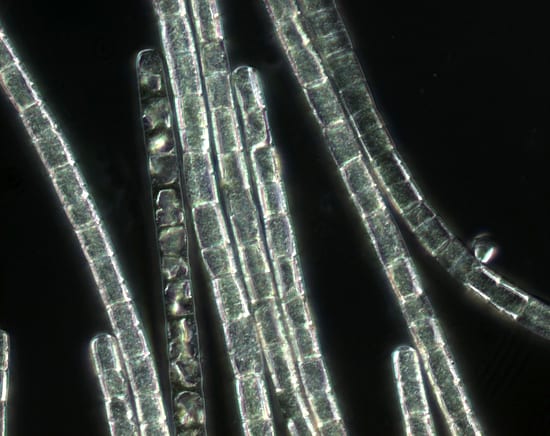 MIT/WHOI graduate student Annette Hynes captured this microscope photograph, or micrograph, of a colony of Trichodesmium at 1000x magnification. A form of primitive, nitrogen-fixing cyanobacteria, Trichodesmium are often found in tropical and subtropical oceans where they contribute significantly to the cycling of carbon, nitrogen, phosphorous, and iron. Hynes and advisor John Waterbury are conducting biogeochemistry experiments to determine how different species of the bacteria respond to different environmental conditions and niches. (Annette Hynes, Woods Hole Oceanographic Institution)
MIT/WHOI graduate student Annette Hynes captured this microscope photograph, or micrograph, of a colony of Trichodesmium at 1000x magnification. A form of primitive, nitrogen-fixing cyanobacteria, Trichodesmium are often found in tropical and subtropical oceans where they contribute significantly to the cycling of carbon, nitrogen, phosphorous, and iron. Hynes and advisor John Waterbury are conducting biogeochemistry experiments to determine how different species of the bacteria respond to different environmental conditions and niches. (Annette Hynes, Woods Hole Oceanographic Institution)
SEARCH RELATED TOPICS: Marine Microbes
Image and Visual Licensing
WHOI copyright digital assets (stills and video) contained on this website can be licensed for non-commercial use upon request and approval. Please contact WHOI Digital Assets at images@whoi.edu or (508) 289-2647.
